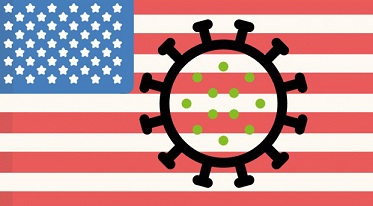COVID-19 News: COVID-19 Hospitalizations In United States Reaches Levels Not Seen Since Omicron Debut In Late 2021. Almost 30,000 Hospitalized Now!
Nikhil Prasad Fact checked by:Thailand Medical News Team Dec 30, 2023 1 year, 3 months, 2 weeks, 3 days, 3 hours, 13 minutes ago
COVID-19 News: The United States finds itself in the throes of an unprecedented public health crisis as COVID-19 hospitalizations soar to levels unseen since the Omicron variant's debut in late 2021. This alarming surge, with nearly 30,000 individuals currently hospitalized, demands a meticulous examination of the various factors fueling this spike.

Additionally, the intensification of flu activity further complicates the healthcare landscape, necessitating a closer inspection of the combined impact of both respiratory illnesses.
https://www.cdc.gov/respiratory-viruses/data-research/dashboard/snapshot.html
This
COVID-19 News report delves into the nuanced aspects of the evolving crisis in America, shedding light on the trends, emerging variants, vaccination rates, regional disparities, and the challenges faced by healthcare systems nationwide.
Rising COVID-19 Hospitalizations: A Prolonged Upward Trajectory
Over the last two months, COVID-19 hospital admissions in the United States have witnessed a relentless and troubling upward trajectory. Health officials anticipate that this trend will persist, attributing the surge to holiday travel and gatherings that have served as breeding grounds for the rapid spread of the virus.
https://covid.cdc.gov/covid-data-tracker/#trends_weeklyhospitaladmissions_select_00
The U.S. Centers for Disease Control and Prevention (CDC) have underscored the gravity of the situation, emphasizing that "COVID-19 activity remains elevated overall and is increasing in many areas." Notably, emergency department visits for COVID-19 are disproportionately affecting vulnerable populations, including infants and older adults.
https://www.cdc.gov/respiratory-viruses/data-research/dashboard/snapshot.html
The Emergence of JN.1 Variant: Understanding the Threat
Adding to the complexity of the situation is the emergence of a new variant, JN.1, which has rapidly become the predominant strain circulating in the U.S. In recent weeks, JN.1 accounted for more than 40% of new infections, swiftly surpassing other variants. Although closely related to BA.2.86, JN.1 stands out as the fastest-growing variant in the nation. The CDC, however, asserts that, at present, there is no evidence suggesting increased risks to public health relative to other circulating variants. Encouragingly, existing COVID-19 tests, treatments, and vaccines are expected to remain effective against JN.1. However, concerns arise due to persistently low vaccination rates, potentially contributing to the variant's increased transmission.
https://covid.cdc.gov/covid-data-tracker/#variant-proportions
<
a href="https://www.cdc.gov/respiratory-viruses/whats-new/SARS-CoV-2-variant-JN.1.html">https://www.cdc.gov/respiratory-viruses/whats-new/SARS-CoV-2-variant-JN.1.html
Vaccination Challenges: A Significant Gap in Uptake
National survey data reveals a glaring gap in vaccination uptake, with only 19% of adults having received the updated COVID-19 vaccine.
https://www.cdc.gov/respiratory-viruses/data-research/dashboard/vaccination-trends-adults.html
This stark reality signals a significant hurdle in achieving widespread immunity and preventing severe disease outcomes. Public health officials express grave concern over this low uptake, emphasizing that it may lead to a surge in severe disease cases. The U.S. CDC has warned that, given the combination of low vaccination rates and the emergence of new variants, millions of people may fall ill in the coming months, posing a substantial threat to public health.
Regional Disparities and Hot Spots: A Patchwork of Impact
COVID-19 severity markers indicate a disproportionate impact on different regions, with the Midwest and Northeast emerging as hot spots for the current surge.
Hospitalizations have surged by 16.7%, and deaths have increased by 10% compared to the previous week. In the week leading up to Christmas, approximately 29,000 individuals were admitted to hospitals for COVID-19, with some counties in the Midwest and Northeast classified as high risk.
https://covid.cdc.gov/covid-data-tracker/#datatracker-home
The patchwork of impact across regions underscores the need for targeted interventions to address the unique challenges faced by each community.
Flu Activity Intensifies: A Dual Threat
Simultaneously, the nation is grappling with a significant increase in flu activity, adding a layer of complexity to the healthcare landscape. According to the U.S. CDC's FluView update, the Southeast is experiencing the highest level of flu-like illness activity, with New Mexico also reporting elevated flu activity. Test positivity for flu at clinical labs exceeds 20% in certain regions, compounding the challenges faced by healthcare systems.
https://www.cdc.gov/flu/weekly/index.htm
Wastewater Tracking and Other Indicators: Unveiling the Escalating Trends
Various indicators, including wastewater tracking by Biobot, highlight the escalating virus levels in the Midwest and Northeast.
https://biobot.io/data/
https://www.cdc.gov/nwss/rv/COVID19-nationaltrend.html
Nationally, the virus level is approaching that seen at the same time last year. Other metrics, such as emergency department visits, test positivity rates, and early indicators, are also on the rise, particularly in the Midwest and Northeast. Wastewater tracking serves as a valuable tool in understanding the community-level spread of the virus and provides insights into the effectiveness of public health measures.
Pediatric Impact and Flu-Related Deaths: A Tragic Toll
The impact on children is a significant concern, with outpatient visits for flu-like illness rising to 6.1%. Flu hospitalizations are increasing across all age groups, with seniors, adults aged 50 to 64, and children under 4 being the most affected. Tragically, seven additional pediatric flu deaths were reported, bringing the total to 20 for the current flu season. Notably, four of these deaths were linked to influenza A, with both subtyped viruses being 2009 H1N1.
Conclusion
In conclusion, the convergence of rising COVID-19 hospitalizations, the emergence of new variants like JN.1, and a simultaneous increase in flu activity presents a multifaceted and unprecedented public health crisis. Urgent measures are needed to address regional disparities, bolster vaccination efforts, and enhance public health interventions. As the nation grapples with this complex and evolving challenge, a collective and coordinated response is essential to mitigate the impact on individuals, communities, and the healthcare system. The coming months will be critical in determining the trajectory of the crisis and shaping the strategies needed to navigate these uncharted waters.
For the latest
COVID-19 News, keep on logging to Thailand Medical News.
